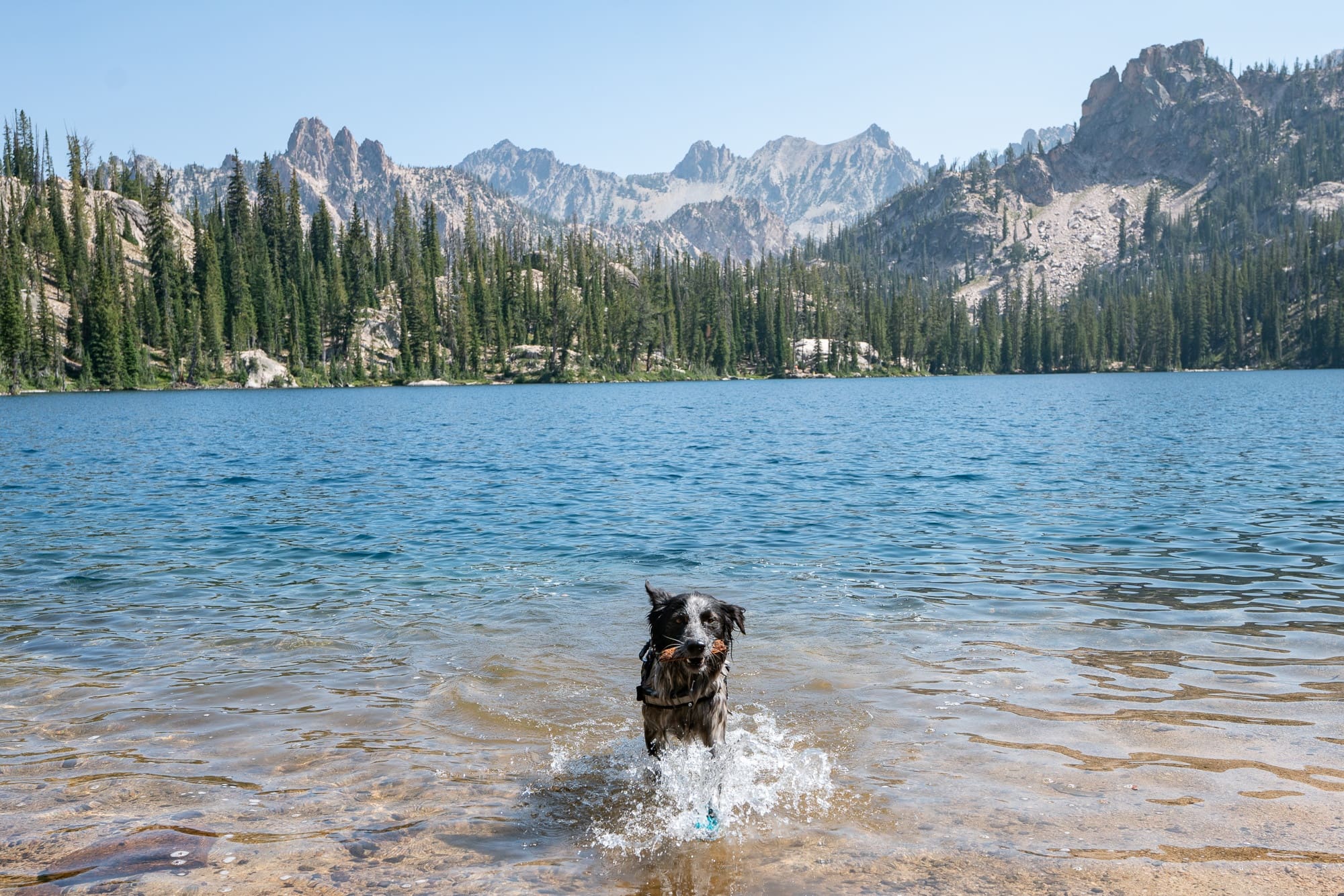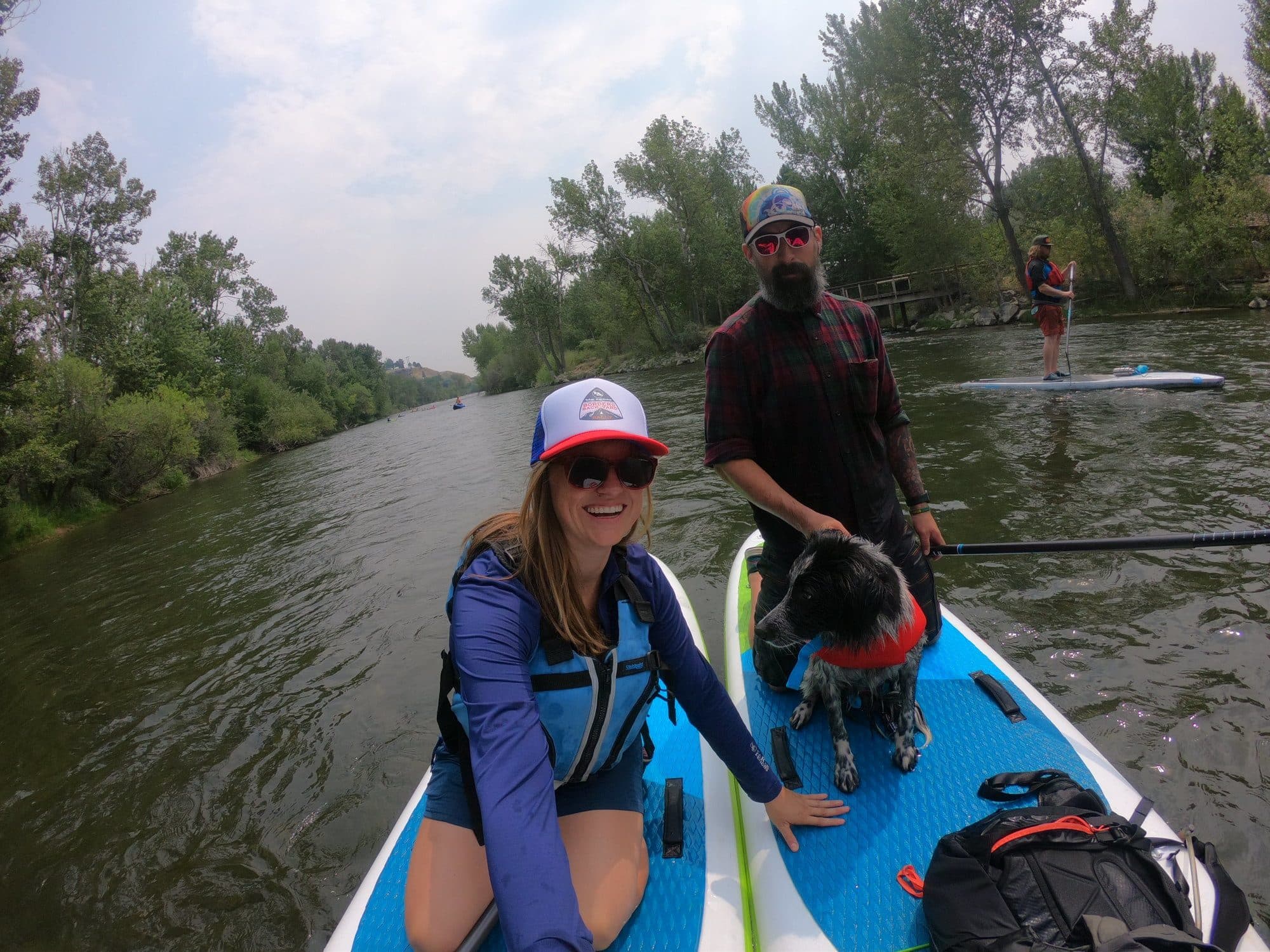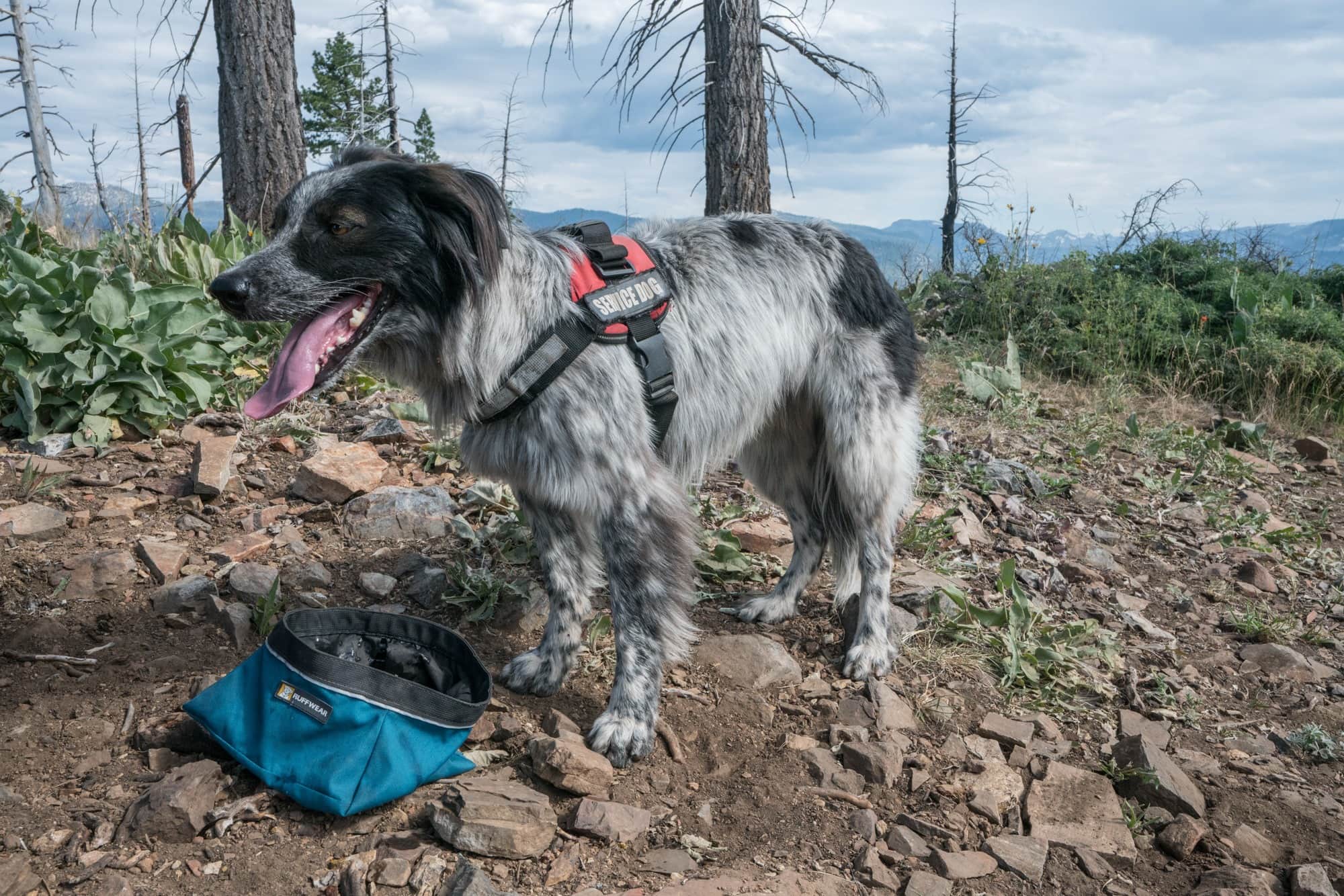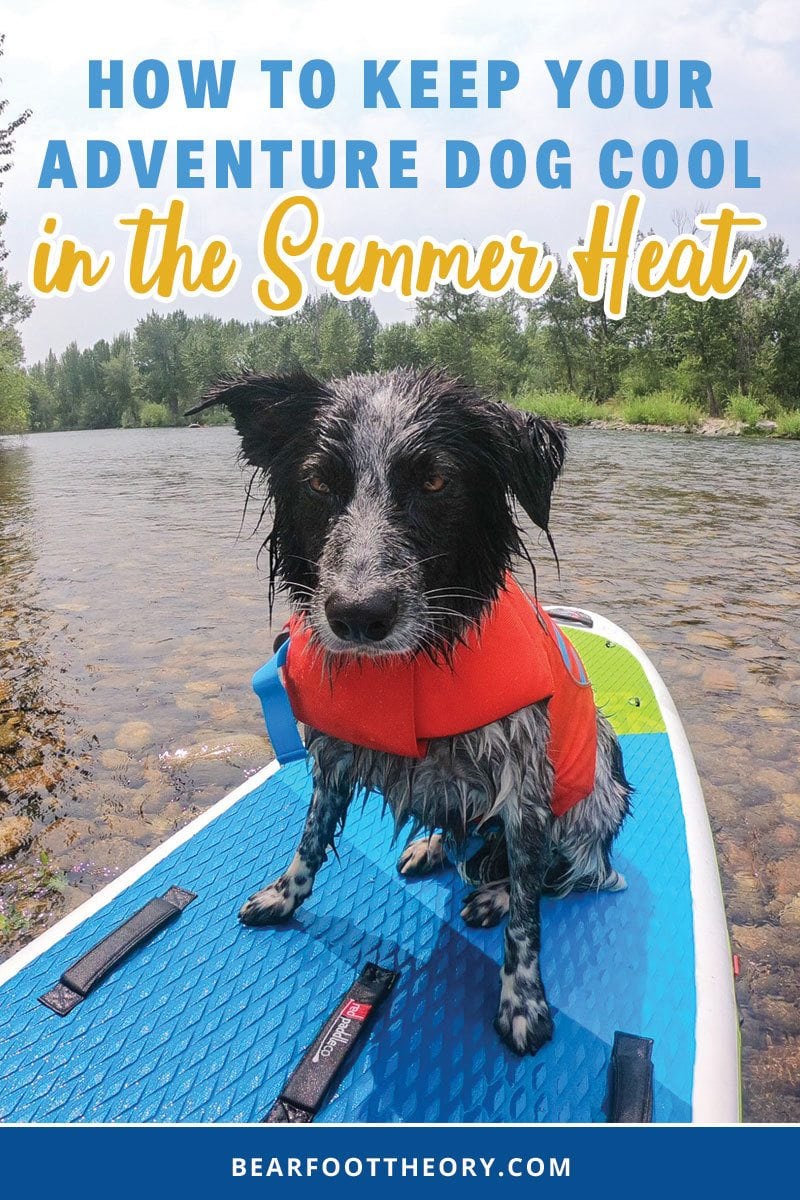How to Keep Your Adventure Dog Cool in the Summer Heat
An expert guide on how to keep dogs cool in the summer heat; including do’s & don’ts, products for staying cool, and warning signs to watch for.

HOW TO KEEP YOUR ADVENTURE DOG COOL IN THE SUMMER HEAT
At Bearfoot Theory we love our dogs AND we love the summer, but sometimes the two just don’t mix well. Our dog Charlie loves hiking, but the heat can be tough on him. If you’ve ever questioned taking your pup out for a hike on a hot day or even wondered how to keep your dog cool in the summer heat at home you’re not alone.
To help answer some of these questions, we turned to a fellow outdoor-loving veterinarian for some advice.
From dos and don’ts to warning signs and even a few favorite products, here is your expert guide to on how to keep your dog cool in the summer heat.
[separator style_type=”icon” /]
1) If It’s Over 85 Degrees, Keep Your Dog Inside
This one hurts, but it’s true. While we love to take our dogs out on adventures with us every chance we get, they simply cannot handle this kind of heat. Veterinarian Dr. Lauren Stoltze, DVM, MS of Franklin Lakes Animal Hospital in New Jersey says the best place for your pooch on hot days is indoors. “I am a big advocate of exercising with your pet, but it’s best to avoid the high heat days entirely”, Stoltze says. Dogs aren’t as good at cooling themselves off as efficiently as humans are, so the myth that if you can stand the heat than your dog can too, can put them at risk of overheating and dehydration.
Side note: While this may seem obvious to many of you remember to never, EVER leave your dog in a hot car. “Cars can heat up rapidly. On an 85 degree day, a car can go to 102 degrees in 5 minutes and 120 degrees in 30 minutes” Stoltze cautions.
[separator style_type=”single” /]
2) Take an Early Hike
Schedule your hike, walk, or run in the early morning to avoid the blazing sun and take advantage of the cooler air temperatures. With morning hikes, the ground may also still be damp from the morning dew which helps you and your pup stay cool. The same goes for pavement and sand which tend to be hotter during the afternoon.
[separator style_type=”single” /]
3) Choose a trail with water & shade
To keep dogs cool in the summer, be strategic and pick a trail where you can hop in a lake or a pond. Stoltze recommends letting your dog go for a swim while you’re hiking to let their core body temperature cool down. We notice Charlie immediately perks up on our hikes as soon as he gets in the water.
Post-hike, you can break out an old kiddie pool (or even hose them down!) and fill it up for your pup so they can have a nice cold soak.
[separator style_type=”single” /]
4) Do a water-based activity instead of hiking
Like we learned from Stoltze in the first point, hiking and biking with your dog on very hot days can put your dog at risk. But what if you have a dog like Charlie who needs ALOT of stimulation EVERY SINGLE DAY? Maybe it’s time to find a new activity. Have you tried stand-up paddleboarding with your dog? We’ve been getting into that this summer and while it’s not as aerobic for Charlie as running, it still provides mental stimulation.
You can also take your dog to a dog-friendly beach and play some fetch in the water if your dog likes to swim.
[separator style_type=”single” /]
5) Pay attention to your dog’s appetite
It’s not uncommon for a dog’s appetite to decrease in the summer. If you notice that your dog is eating less, than you may need to adjust their diet or activity levels to make sure they aren’t overdoing it. We always bring treats on the trail and have Charlie’s food with us in the van.
[separator style_type=”single” /]
6) Protect Your Dog’s Paws
If you happen to be hiking on a paved surface or even just taking your pooch for a walk, you’ll need to be mindful of the effect that a hot surface warmed by a sizzling sun can have on your dog’s paws. “Paw pad injuries from thermal burns can cause the paw pads to “slough”, or fall off, warranting vet visits, bandages, antibiotics and pain medication,” Stoltze says. “On an 85-degree day, asphalt can heat to 135 degrees, a temperature that can fry an egg in 5 minutes.”
So, what’s the best way to prevent this? Stoltze recommends testing it out yourself first. “A good test is to press your barefoot or the back of your hand onto to the ground for 7 seconds – if it’s too hot for your skin, it’s too hot for their paw pads.” If your dog does suffer thermal burns get them to your local veterinarian immediately.
Booties or No Booties?
Should you use booties to help keep your dog cool and safe from hot surfaces? Stoltze says it might actually make things worse. Since your pup releases heat through their paw pads it won’t help cool them down. Instead, the booties “tend to trap heat in.” However, they can help prevent paw pad injuries on rough hiking terrain.
The final verdict? While booties won’t keep them cool, we do find that using them on longer hiking days help protect Charlie’s paw pads from getting too beat up. We also used them at music festival we recently attended where the pavement was hot and leaving him in the van was not an option. We’ve tested a few different brands but found that the Ruffwear Grip Trex, All-Terrain Paw Wear Booties stay on the best and are more durable than cheaper alternatives we found on Amazon. That said, the booties can create problems of their own. We’ve found that in order to stay on, they have to be very tight and over several hours, they cause irritation where the velcro tightens. So our advice is to use booties sparingly.
We also use a wax-based product called Musher’s Secret that works for preventing cuts and cracking. When we hike with Charlie, we put it on his paws at the end of the day. It moisturizes the paws and creates a protective barrier when your dog is walking on rough surfaces.
[separator style_type=”single” /]
7) Bring enough drinking water for you and your dog
Whether your pooch is inside or out, you should always make sure you leave them with water to drink; throwing a few ice cubes in there isn’t a bad idea either and it might even encourage them to drink more. While you’re on a hike, bring a reusable water bottle to keep your dog hydrated. There are many products to help you give your dog water when you are on-the-go like collapsible bowls and water bottles with various types of built-in bowls. “They make water bottle attachments that allow a dog to more easily drink from a water bottle or collapsible nylon water bowls to easily fill and then fold to flat to take up minimal space in a backpack,” says Stoltze who is also an avid hiker and dog owner.
While our dog Charlie seems to have a pretty hearty gut, remember, just like you would filter your own water, you should also filter a dog’s water on a backpacking trip. Don’t just scoop water directly from a stream into their bowl. They are susceptible to the same pathogens, like giardiasis, as we are, and a sick dog on the trail is not a good thing.
[separator style_type=”single” /]
8) Use a cooling vest
Consider investing in the Swamp Cooler Vest by Ruffwear, a vest that has an integrated cooler to keep your dog cool and reflect the heat from solar radiation. Stoltze signs off on this, adding that, “cooling vests can definitely be a big help, but can’t do all of the work done by a human covered head to heel with sweat glands, and they shouldn’t take the place of good decisions associated with heat exposure.” So don’t just slap a cooling vest on and think you don’t have to worry about the heat.
[separator style_type=”single” /]
9) Learn the Warning Signs of Dehydration in Your Dog
Dogs can get dehydrated and suffer a heat stroke just like humans. Keeping your dog cool in the summer heat isn’t just about making sure they are comfortable, but that they are safe. Knowing the warning signs of dehydration in your dog can make all the difference; “any of these signs warrant an immediate vet visit” Stoltze says. Here are the symptoms to watch for:
- Excessive panting
- Weakness
- Vomiting
- Drooling
- Lethargy
- Dark red gums
- Incoordination
- Rapid heartbeat
- Seizures
If you think your dog is in danger of overheating, Stoltze recommends calling ahead to make sure your dog can get treated for this time-sensitive issue. “On the way to the vet, you can apply rubbing alcohol to the paw pads to help cool them down. You can also apply cool (but not freezing) water to their bodies, as cooling them down too quickly can be detrimental as well” Stoltze says.
[separator style_type=”single” /]
10) Other Advice for how to keep dogs cool in the summer
Besides the above tips for how to keep dogs cool in the summer, here are a few more important facts to remember when you take your dog hiking in the heat.
- Very short-haired dogs or shaved dogs can get a sunburn just like people
- Don’t shave your dog to keep them cool in the summer, Stoltze says “their fur coat helps them regulate their body temperature to help them stay cool and can protect from sunburn”
- “Dogs only “sweat” or dissipate heat through their paw pads and by panting,” Stoltze says, unlike humans who have nearly every square inch available to release internal heat
- According to Stoltze, all dogs are susceptible to overheating but brachycephalic, or short-nosed breeds like pugs, bulldogs, and boxers, can suffer the ill effects of heat stroke quicker and more severely than other breeds
- Stoltze highly recommends using a harness instead of a neck lead to limit pulling on the trachea which can limit their ability to pant and cool down
[separator style_type=”single” /]
What advice do you have for how to keep dogs cool in the summer heat? Leave a comment below!
[content_box title=”Read Next”]
How to Road Trip with Your Dog
Tips for Backpacking with Your Dog
The Most Dog-Friendly National Parks
Dog-Friendly Fireside Resort in Jackson
Dog-Friendly Limelight Hotel in Sun Valley Idaho
Wildlife Safety Tips & Preventing Encounters
[/content_box]







We have a yellow lab who wants to go full tilt at everything life offers him. He can go ten miles mountain biking easily but since he doesn’t do that in his daily life his paw pads aren’t acclimated to it and really destroys his paw pads. We’ve tried every shoe brand out there including the ruff trax above. Unfortunately none are made for a dog to go full tilt. We also had the blisters and raw spots where the boots Velcro even with the ruff brand socks under them. Hopefully someone can fill this market niche and help us all out! We also do the mushers secret and it does seem to help soothe.
I am a new follower and curious about Charlie as a DAD. I am getting a well trained GSD rescue soon and want to train for DAD work. Did you self-train? Type 1 or 2? Is he alerting to both highs and lows? If you self-trained, what method did you use? How much do you have to keep up “sample” training if you don’t have many lows/highs in a week or month? I have pretty tight control and would love to see if my new dog will be able to alert if taught. TIA for comments.
Hi Missy – We have been self-training for Type 1 under the guidance of a trainer: https://tythedogguy.com/ . When you have a high or low, you take a mouth swab and then you double wrap it in baggies and store them in the freezer. that way you get a lot of samples from one high or low incident. The idea is to alert to both highs and lows. We are still training and from what it seems, you have to keep training throughout the dog’s entire life. Hope that helps and let me know if you have other questions!